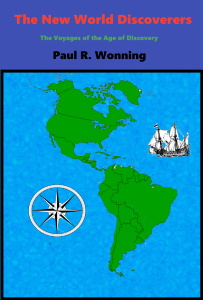From the Book:
The New World Discoverers
Transcript:
Greetings, this episode recounts Henry Hudson’s four voyages of Discovery to what is now New York and the Hudson Bay Region
September 3, 1609 – Hudson Sailed Into New York’s Harbor
Commissioned to find a northern route to Asia by the Dutch East India Company, Henry Hudson explored New England coast. He sailed into Hudson Bay on September 3, 1609.
Henry Hudson (1565? – 1611?)mm
His early youth clouded in mystery, many believe Henry Hudson began his life at sea as a cabin boy. He rose in stature, finally becoming an excellent navigator and captain. He made two voyages in 1607 and 1608 for the British Muscovy Company. The company commissioned him to find the fabled Northwest Passage. His explorations of the seas of the Arctic area found nothing but a land of ice and snow. The English and the Dutch struggled for control of North America, searched for the Northwest Passage. The Dutch East India Company hired Hudson in 1609 for a third voyage to find the passage.
The Dutch East India Company
The Dutch East India Company was a chartered company established by the States General of the Netherlands in 1602. Many historians consider the powerful company as the first multi-national company. It was the first company to issue stock and had almost governmental powers. These included minting coins, negotiating treaties with foreign powers and establishing colonies. This search for the Northwest Passage led to their commissioning of Hudson’s voyages.
Attempt to Find the Northwest Passag
The Dutch East India Company instructed Hudson to sail across the sea to Russia’s northern shore. He was to find a path to Asia by findthe elusive northern route for which the European nations searched. He departed Amsterdam harbor on April 4, 1609 on the ship Half Moon (Halve Maen). He sailed northeast to search for a passage through the Arctic Ocean. Ice blocked the sea everywhere he went, so he went outside his instructions and turned his ship west. By July 2, they reached LaHave, Nova Scotia, where they landed. They encountered some natives here, who had prior contact with French traders. Apparently, Hudson tried to trade for some furs, but was not successful. The ship needed some repairs, so they lingered in the area. Around July 25, the crew raided a native village and drove the inhabitants off. They stole some items and left.
The ship continued south, reaching Chesapeake Bay on August 4. Hudson did not enter the bay, but sailed north, entering New York Bay on September 3.
Giovanni da Verrazzano had visited the area in 1524 in his search for the Northwest Passage. Hudson was the first to visit since that time. He entered the Upper Bay of the Mauritius, or North River, on September 12, 1609 and began ascending the river on September 13. Cartologists later changed the name to the Hudson River in honor of Hudson. He would voyage upriver until reaching the approximate location of Albany, New York.
By September 23, 1609, Hudson decided it was time to end the voyage. He departed North America and arrived at Dartmouth, England on November 7. English authorities tried to confiscate his logbook, but Hudson slipped it to the Dutch ambassador. The ambassador sent it to Dutch authorities in Amsterdam. The Dutch would use this voyage to establish their claim to New Amsterdam later on.
On his fourth and final voyage, Hudson departed Europe and sailed his ship Discovery through the turbulent waters of the Labrador Sea and Davis Strait. On August 2, 1610, Hudson’s ship entered the bay that would bear his name, Hudson’s Bay. After three month’s at sea, Hudson was confident he had found the elusive Northwest Passage. Hudson and his crew would spend the next two months sailing around the Bay, looking for a route through, until ice closed in on the ship in late October.
Fed up with Hudson’s poor leadership and seamanship, the crew of the Discovery mutinied. They put Hudson and seven others in a small boat somewhere in the middle of the ice-laden waters of James Bay in northern Canada. The crew set sail, never to see Hudson or the others again.
The Discovery returned to London on October 20, 1611 after suffering a shipwreck and other hardships. The British authorities imprisoned them, recommending that they be hanged. The prisoners did not receive trials until seven years later. Many of the men died before the trials occurred. The remainder were exonerated and freed, perhaps to cover up the details of the disastrous voyage.
This story is exerpted from my book, The New World Discoverers. Listeners can find the book on Amazon, Barnes and Noble, Kobo and other online retailers. You can also buy the book direct from me on my website, http://www.mossyfeetbooks.com. You can contact me an mossyfeetbooks@gmail.com
This story is exerpted from my book, The New World Discoverers. Listeners can find the book on Amazon, Barnes and Noble, Kobo and other online retailers. You can also buy the book direct from me on my website, http://www.mossyfeetbooks.com. You can contact me an mossyfeetbooks@gmail.com
Thank you for listening.
.
Visit Mossy Feet Books on Facebook
Top of Page
Mossy Feet Books on Social Media
Twitter
Linkedin
Instagram
YouTube
Pinterest
Online Sources for Mossy Feet Books
Paul Wonning’s Books on Amazon Page
Paul Wonning’s Books on Scribd Page
Paul Wonning’s Books on Apple
Paul Wonning’s Books on Kobo
Paul Wonning’s Books on Barnes and Noble
Paul Wonning’s Books on 24 Symbols
Paul Wonning’s Books on Google Play
Paul Wonning’s Books on Indigo
Paul Wonning’s Books on OverDrive
Search Paul Wonning on Ingrams
Table of Contents
© 2022 Paul Wonning

